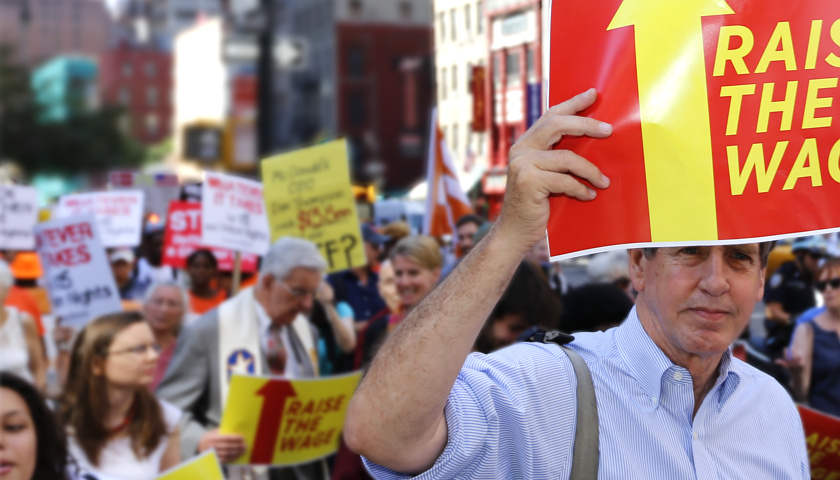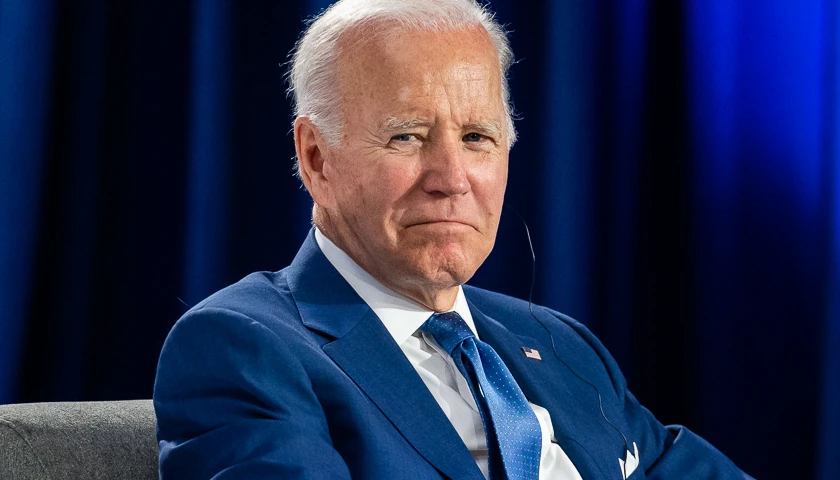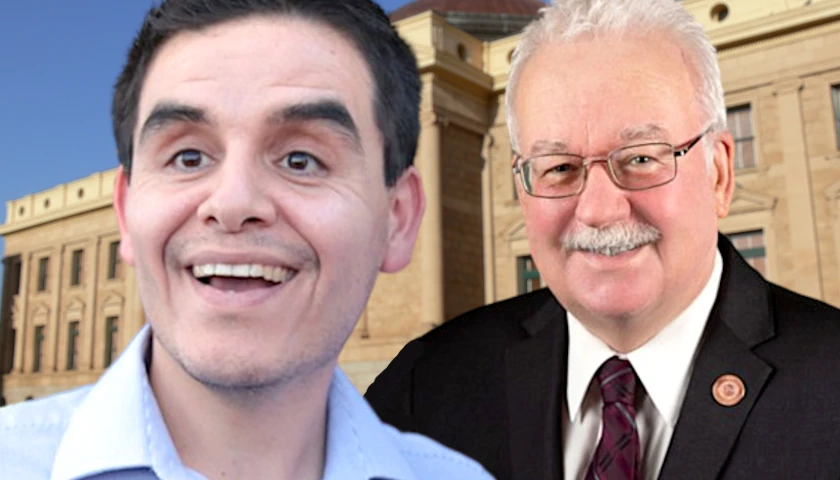by Mark J. Perry
In a 2014 letter written by the Economic Policy Institute (EPI) to President Obama and congressional leaders in support of an increase in the federal minimum wage to $10.10 an hour, more than 600 economists apparently agreed with, and endorsed this statement:
Research suggests that a minimum-wage increase could have a small stimulative effect on the economy as low-wage workers spend their additional earnings, raising demand and job growth, and providing some help on the jobs front.
More recently, EPI endorsed a $15 an hour federal minimum wage and estimated that:
The rising wage floor would generate $144 billion in additional annual wages, which would ripple out to the families of these workers and their communities. Because lower-paid workers spend much of their extra earnings, this injection of wages would help stimulate the economy and spur greater business activity and job growth.
Seems almost like economic magic right? Through a government edict in the form of an artificial price control (minimum wage law), we can stimulate the entire US economy and increase national income, prosperity, and jobs!
And here’s the latest from EPI on the pending increases in state minimum wages next week:
At the beginning of 2018, 18 states will increase their minimum wage, providing more than $5 billion in additional wages to 4.5 million workers across the country. In a majority of these states, minimum wage increases (ranging from $0.35 in Michigan to $1.00 in Maine) are the result of legislation or ballot measures approved by voters in recent years.
According to the narrative of minimum wage advocates like EPI, that $5 billion in additional wages will get spent by low-skilled workers on goods and services, and with the power of a mythical multiplier that spending will ripple through the economy and magically stimulate the entire economy, create jobs, and bring about prosperity!
But here’s a question that never gets asked (or answered) by EPI and minimum wage supporters: Where will the $5 billion in additional wages come from? While thinking about this overlooked question that reveals an important economic fallacy, I was reminded of a similar economic fallacy illustrated by Henry Hazlitt’s famous essay on the broken window, which exposed the economic fallacy of the “blessings of destruction.” Using Henry Hazlitt’s essay as a template (which is actually based on Bastiat’s original essay on the broken window fallacy from 1850), I expose what might be called the “blessings of the minimum wage fallacy” as no less than 18 minimum wage increases are set to take place this week.
The Blessing of the Minimum Wage Fallacy
From Henry Hazlitt’s Economics in One Lesson, we learn that “the whole of economics can be reduced to a single lesson, and that lesson can be reduced to a single sentence: “The art of economics consists in looking not merely at the immediate but at the longer effects of any act or policy; it consists in tracing the consequences of that policy not merely for one group but for all groups.” Let us begin with a simple illustration: the 18 minimum wage hikes that went into effect Monday, January 1.
As a result of of those mandates, minimum wage workers now get paid $0.35 (in Michigan) to $1 an hour (in Maine) more. A young teenage worker named Alex working full-time at a small neighborhood pizza restaurant in Maine would make $160 in additional income every month (ignoring taxes). Alex would spend that additional monthly income of $160 at local merchants on items like food, clothing, footwear, Uber rides, movies, computer games, and electronics items. The local merchants who receive that $160 from Alex’s additional spending now have additional income and profits every week, and they can spend some of that additional income and profits on goods and services. Alex’s additional monthly income, therefore, ripples through the local Maine economy with an amazing multiplier effect that almost magically increases spending and income throughout the local economy.
The pro-minimum wage crowd points to these many positive income effects from Maine’s new $11 an hour minimum wage and Alex’s additional income, and many might even suggest that a minimum wage far above $11 an hour would create even greater and more positive benefits for workers like Alex and the local merchants who would be the beneficiaries of an even higher minimum wage. For example, EPI suggests that a $15 an hour federal minimum wage would lift wages for 41 million American workers.
But let us take another and closer look at the situation. The minimum wage crowd is at least right in its first conclusion about Alex’s spending, which is just a small part of the much larger $5 billion in additional wages and spending EPI estimates for next year. The public policy of artificially raising wages through government fiat will mean more business and billions of dollars in greater sales revenues for local merchants around the country. The local merchants will be no more unhappy to learn of the magical spending from 18 minimum wage hikes in 2018 than an undertaker to learn of a death.
However, we haven’t yet considered the situation that now face hundreds of thousands of merchants and small business owners next year, including Alex’s boss – Mrs. Alice Johnson who owns the small pizza restaurant in Bangor where Alex works. As a result of Alex’s good fortune to receive $160 in extra income every month (and nearly $2,000 during the entire year) as a result of government fiat, his boss and sole-proprietor Alice Johnson now has $160 less every month (and $1,920 for the year) because she has to pay Alex out of her own income or profits.
The Johnson family now has to cut back on their household spending by $160 every month that they would have spent on food, clothing, Uber rides, and electronics products at local merchants. Alex’s gain of $160 each month comes at the direct expense of the Johnson family, who are now worse off in the same amount that Alex is made better off. (And if Mrs. Johnson employs more minimum wage workers than just Alex, she and her family are worse off by $160 per month, and $1,920 per year, for each worker.)
If we consider that Alex and the Johnson family are a part of the same local community in Bangor, the community’s income hasn’t changed. Rather, there’s only been a transfer of income of $1,920 per year from the Johnson family to Alex; but no net gain in community income, wealth, jobs, or prosperity has been achieved.
For the entire state of Maine, the $80 million in higher wages that EPI’s estimates next year as a result of the $1 an hour increase in the state’s minimum wage have to come from somewhere or someone. And that “somewhere” or “someones” are the thousands of local merchants in Maine like Mrs. Johnson who will be made collectively worse off by $80 million in 2018.
The people in the pro-minimum wage crowd think narrowly of only two affected groups from minimum wage hikes: Alex, the minimum wage worker, and the merchants that gained his business from his artificial increase in income. The minimum wage advocates forget completely about the third parties involved, namely small business owners and their families like the Johnsons in Maine, and the local merchants that now lose their business because the labor costs for small businesses have been artificially increased by government fiat.
Minimum wage advocates will easily see Alex’s increased income and spending because it is immediately visible to the eye and easy to calculate ($5 billion next year according to EPI, and $144 billion annually if the federal minimum wage is increased to $15 an hour). They fail to see the lost income and subsequent reduction in spending by the Johnson family that otherwise would have occurred – because it’s less visible and harder to calculate.
The minimum wage example above exposes an elementary fallacy about its alleged positive income effects. Anybody, one would think, would be able to avoid that fallacy after a few moments thought. Yet the minimum wage fallacy, under a hundred disguises, is the most persistent in the history of economics. It is more rampant now than at any time in the past. It is solemnly reaffirmed every day by great captains of industry, by labor union leaders, by editorial writers and newspaper columnists, by progressive politicians and progressive think-tanks, by learned statisticians using the most refined techniques, and even by professors of economics in our best universities who sign statements in support of the minimum wage. In their various ways, they all perpetuate the minimum wage fallacy.
It All Has to Come from Somewhere
The minimum wage supporters see almost endless benefits despite the economic destruction that characterizes minimum wage laws. They see miracles of multiplying prosperity, increased income, and more jobs coming from minimum wage hikes, a form of economic magic enacted in state capitals, by city councils, and the federal government. But once we trace the long-term effects of such public policy on all groups in the economy, and analyze both what is seen and what is unseen, we should easily understand that the minimum wage cannot, and will not, have overall positive effects. At best it can only transfer income from one group (business owners like Mrs. Johnson above and/or their customers in the form of higher prices) to another group (low-skilled, limited-experienced workers), but with no net gain.
It’s an ironclad law of economics that to stimulate one group with public policies like the minimum wage, protective tariffs, or farm subsidies, another group in the economy has to be equally “un-stimulated.” In the case of the 18 increases next week in state minimum wages, the EPI’s estimate of $5 billion in additional wages will stimulate low-skilled workers next year by the exact same amount that it will “un-stimulate” merchants, businesses, business owners, and their families in those 18 states – by $5 billion.
When one considers all of the long-term effects on all groups that would result from minimum wage laws: the economic distortions, the misallocation of resources, the loss of employment opportunities for low-skilled workers and the lifetime consequences of not gaining work experience at an early age, and the businesses that close or are never opened, one can only come to one conclusion: the minimum wage law is a very bad and very cruel public policy that makes local communities and the entire economy overall much worse off, not better off.
Groups like EPI that support increasing the minimum wage do a great job of addressing the benefits of higher wages to low-skilled workers, but then completely ignore the costs of those artificial wage increases. That is, they never answer the most important question of all, posed above: Where will the $5 billion in additional annual wages from the 18 minimum wage hikes next year come from?
For example, in a 60-page document released earlier this year by EPI’s senior economic analyst David Cooper, “Raising the minimum wage to $15 by 2024 would lift wages for 41 million American workers,” there is extensive coverage on every page of the estimated benefits of artificially higher wages ($144 billion annually) to various workers by demographics (age, gender, race/ethnicity, education, family status, children, geography, etc.) that would result from a $15 an hour federal minimum wage. But you won’t find a single sentence in the 60-pages of text that explains where the $144 billion will come from if the federal minimum wage is increased to $15 an hour!
There’s not a single mention in the EPI report of the word “business” except for a reference to a $15 minimum wage “spurring greater business activity and job growth.” There’s also not a single mention of what should be relevant terms like “higher prices,” “labor costs,” “profits,” “adjustments,” or “reduced hours” that would give us some idea of the costs of a $15 an hour minimum wage, who pays those costs (businesses), and how those higher costs will offset the benefits. And that’s the essence of the “blessings of the minimum wage fallacy” that EPI has fallen prey to – a $15 minimum wage sounds like good public policy only when you count all of the blessings (benefits) to workers while ignoring the costs to businesses.
We learned from Bastiat and Henry Hazlitt that broken windows and other forms of destruction can’t increase a community’s overall income, employment, and economic prosperity. Likewise, neither can the 18 minimum wage hikes scheduled to take place on Monday have overall, positive net economic benefits next year.
Any public policy looks good when you look merely at the immediate effects, but not the longer effects; when you consider the consequences for just one group (workers in the case of the minimum wage) but for all groups (businesses), and only emphasize the benefits (to workers) while completely ignoring the costs (to employers). But that’s not sound economic logic or objective economic analysis on the part of groups like EPI; rather it’s pure partisan political advocacy for an economic fallacy that violates the ironclad law of economics described above. Or as Milton Friedman described it in 1966, support of the minimum wage is “monument to the power of superficial thinking.”
Update: As FEE.org commenter “Not Sure” points out, there is an additional cost to employers when the minimum wage increases because of the 7.65% payroll tax imposed on employers for Social Security and Medicare. Therefore, the $5 billion in higher wages next year for minimum wage workers would actually cost their employers $5.3825 billion.
– – –
Mark J. Perry is a scholar at the American Enterprise Institute and a professor of economics and finance at the University of Michigan’s Flint campus.






Economics is not the liberal/left’s strong suit. Actually it doesn’t seem to be the strong suit of most of the politicians in D.C. or we wouldn’t have a national debt of over 20 trillion dollars. http://www.usdebtclock.org